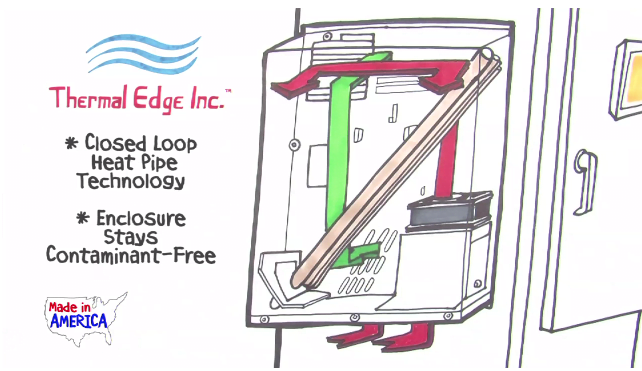How Air to Air Heat Exchangers Efficiently Cool Electrical Enclosures

An air to air heat exchanger is an efficient way to remove heat from electrical enclosures. Apart from two fans, there are no moving parts, and energy consumption is negligible. By utilizing innovative heat pipe technology, air to air heat exchangers are able to transfer heat from inside the enclosure to the external air and are suitable for use in sealed NEMA 12, 4, and 4X enclosures.
Heat Pipe Technology
Heat pipes are sealed pipes that contain a liquid refrigerant held at a very low pressure. The bottom of the pipe is warmed by the air from the electrical enclosure and this causes the refrigerant to vaporize and rise to the top section of the pipe. The top of the pipe is in contact with cooler ambient air, so the refrigerant vapor gives up its heat to the air, condenses and returns to the bottom of the pipe.
The heat pipe is fitted with aluminum fins to increase heat transfer.
Fully Sealed
The top and bottom portions of the heat pipe are in separate compartments. The bottom compartment is completely sealed except to allow the hot air from the top of the electrical enclosure to enter the heat exchanger and the cooled air to return to the enclosure. A small fan is used to provide the air circulation.
The top compartment is exposed to ambient air circulated by a fan to discharge the heat .
Capacity
A heat exchanger depends on the temperature differential between the enclosure’s temperature and the ambient air. The greater the temperature difference, the greater the quantity of heat that is removed. A large heat exchanger removes 40 watts per degree Fahrenheit. So, assuming a temperature difference of 20 °F, the total quantity of heat that is removed is 800 watts or 2,730 BTU/hr. This is equivalent to the capacity of a small air conditioner. The significant feature is that, apart from the power used by the circulation fans, no external energy is required.
Constraints
Because the heat pipe relies on a temperature differential, the ambient air temperature must be cooler than the enclosure operating temperature. This means an air to air heat exchanger can only be used when the ambient temperature is lower than the desired enclosure temperature. However, this constraint also applies to filtered fans. In addition, a requirement of the heat pipe design is that it’s installed vertically.
Applications
The low energy consumption, heat transfer capacity, and robust construction of air to air heat exchangers means they are well suited for enclosure cooling where the environment precludes the use of fans. Some examples include:
- Dirty and dusty locations: The closed loop design of the air to air heat exchanger permits the use of sealed enclosures without the need to use more expensive air conditioning equipment.
- Wet and corrosive locations: Units can be hosed down, are corrosion resistant and suitable for use in locations requiring NEMA type 4 and 4X protection.
- Remote installations: The robust construction and low power consumption allow unattended operation. DC powered models are available for battery or solar power.
Save Costs with Air to Air Heat Exchangers
Thermal Edge’s air to air heat exchangers offer a low-cost closed loop cooling solution that’s a preferred alternative to filtered fans. Their low energy consumption, tolerance for dirty and polluted environments, and NEMA types 12, 4, and 4X enclosure ratings combine to offer a superior yet cost-effective solution. Contact our sales team to see how air to air heat exchangers will improve your enclosure cooling.

